Adventures from a Traveler’s Notebook
by Lisa C. Cantwell
Warm and blooming, April lures us outside to take in all the wonders of spring. This month, I’ve chosen a holy site. Far more than a destination, it is a place that invites contemplation, with scenery that delights both city-bound and nature-lover alike. Civil War buffs will also be drawn to this secluded place along the Shenandoah River, seemingly a world away in time, but only 57 miles from Thurmont.
Holy Cross Abbey and Cool Spring Farm, Berryville, Virginia
I found this peaceful place three years ago, when searching for a quiet place in the country from which to write for a few days. A friend recommended it to me, and even though I’m not of the Catholic faith, I knew that some monasteries welcomed the public to stay overnight, attend service, walk the grounds, and even take meals in the dining room. Holy Cross Abbey is such a place. Located on 1,200 farmed acres along the Shenandoah River, just outside Berryville, Virginia, Holy Cross offers lodging and meals in their comfortable Monastery Retreat House. A simple, but clean, single-occupancy room, with a private bath and a view requires a $50 deposit. Rates are determined by you, as the donor, but an offering of $150-$300 for the weekend is suggested. It costs the monks $75 per night to operate the retreat house. Three daily meals and snacks are included, complete with flavored honeys and fruit cake, with just a hint of brandy, made by the Cistercian monks who live there. The only stipulation is that meals must be taken in silence, and quiet within the retreat center is appreciated. I didn’t find the “shhhhh” aspect of the place awkward at all, and I had plenty of opportunity to visit with other guests while on walks about the grounds.
These recollections from my travel journal highlight the “why” of such a getaway:
“I had such joy walking through the quiet of the monk’s cemetery and woods. Lured on by the site of an old barn and silo in the distance, I took a dirt path all the way to the river bottom, past cornfields, Angus cattle, and a show-stopping cast of birds, like red-wings, meadowlarks, bluebirds, cardinals, and Baltimore orioles. Near the river bank stood an old frame, Federal-style home, once proud, now abandoned, but still awash in faded yellow paint. I stood and watched it glow there as I could go no further, its approach entangled in vines and brush. I tried to imagine who lived there and how many boats they waved to, going up and down the Shenandoah. An old orchard, barn, smokehouse, and springhouse spoke of a vast amount of time the family must’ve spent gathering and preparing. I took photos of the Blue Ridge Mountains at sunset, the river sparkling at last light. I said aloud, “Oh, you beautiful farm!” I pray it’s here forever, but the number of monks these days is small, there are few converts.
Besides the pastoral setting of the farm, another lure of this place is history. Cool Spring has been farmed since 1730, and was the site of a significant Civil War battle in 1864. The manse, built in 1784, still stands and houses a spare interpretive exhibit of the Battle of Cool Spring. The second floor of the house contains a collection of tools and arrowheads made by Native Americans found on the place. Although there is no marker on the farm that commemorates the battle, there are several in the region, the nearest being on the Castleman Road approach, off Rt. 7. According to the Civil War Trust site, over 13,000 Union and Confederate soldiers clashed on July 18, 1864, at Cool Spring Plantation over attempting to cross the Shenandoah River. The commanders were Major General Horatio G. Wright, Union, and General Jubal Early, Confederate. The battle was considered a Confederate victory, although both sides suffered similar numbers of casualties: 422 Union troops fell, compared with 397 Confederate troops. The house is open to the public.
Another possibility for a new experience while visiting the Abbey is a rare view into monastic life. Although the quarters of the monks are private, and they are mostly silent, guests are invited to attend scheduled services in their church throughout the day and night. Holy Communion is offered to Catholic guests at the services. The monks pray five times daily, six times on Sunday, beginning at 3:30 a.m. A beautiful, yet unadorned chapel is open in the retreat house for guests who desire independent contemplation. There is also a library for guest use.
The last attraction of Holy Cross Abbey is its gift shop. A barefoot monk in a plain brown robe will greet you and help you choose the perfect icon, statue, baked goods, flavored creamed honey, or my favorite, a brandy-fused fruitcake. I was never a fruitcake fan until I savored a piece made by these humble monks. Store hours vary, so check the website. For more information about Holy Cross Abbey and Cool Spring Farm, visit their website at www.virginiatrappists.org/retreat-house/ or call 540-955-4283.
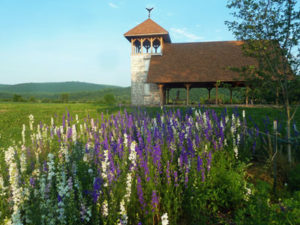
Outdoor Chapel, Holy Cross Abbey.
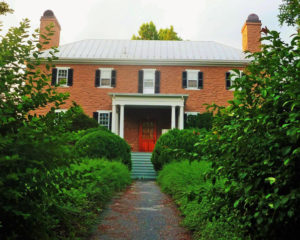
Visit “Cool Spring,” a historic home on the grounds.
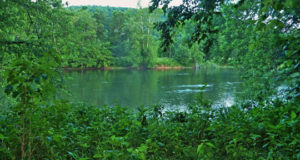
Take a walk along the banks of the Shenandoah River that borders the abbey.
Photo by Lisa Cantwell

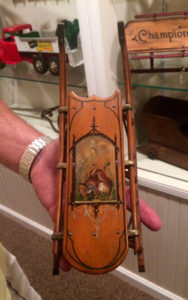 Tressler’s pride and joy is this one-of-a-kind hand-painted sled, made of maple and ash woods with brass fittings and steel runners. The detailed motif is of a hunting dog with a dove in its mouth. This sample measures 9 ½ inches by 3 ¾ inches, and is so rare it is featured in the authoritative resource, Great Sleds and Wagons by Joan Palicia. The manufacturer of this sled sample was America’s most prolific sled maker and first opened in 1861 in Paris, Maine. Children’s sleds to full-size sleds and wagons were produced, and, before the turn of the century, branch stores sprang up in several major cities. Tressler purchased this treasure from an antique dealer near Lancaster, Pennsylvania. In today’s market, he values it between $6,500 and $11,000.
Tressler’s pride and joy is this one-of-a-kind hand-painted sled, made of maple and ash woods with brass fittings and steel runners. The detailed motif is of a hunting dog with a dove in its mouth. This sample measures 9 ½ inches by 3 ¾ inches, and is so rare it is featured in the authoritative resource, Great Sleds and Wagons by Joan Palicia. The manufacturer of this sled sample was America’s most prolific sled maker and first opened in 1861 in Paris, Maine. Children’s sleds to full-size sleds and wagons were produced, and, before the turn of the century, branch stores sprang up in several major cities. Tressler purchased this treasure from an antique dealer near Lancaster, Pennsylvania. In today’s market, he values it between $6,500 and $11,000.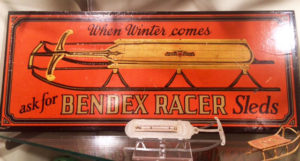 Tressler’s collection began thirty-one years ago, with a tiny sled purchased at an antique store in Frederick for a mere $67.00. There were many sled samples in his showcase, including Flexible, Champion, and Fleetwing brands. Two salesman’s samples were of “summer sleds,” which have wheels. Their full-size counterparts were made between the 1880s and 1920s.
Tressler’s collection began thirty-one years ago, with a tiny sled purchased at an antique store in Frederick for a mere $67.00. There were many sled samples in his showcase, including Flexible, Champion, and Fleetwing brands. Two salesman’s samples were of “summer sleds,” which have wheels. Their full-size counterparts were made between the 1880s and 1920s.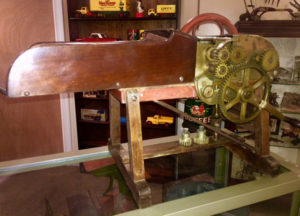 A curious and exceedingly rare piece is “The Sherman Cutter,” or feed grinder, that Tressler found on a popular online auction site. It was misidentified as a “tobacco cutter” and needed some TLC, so he acquired it at quite a bargain. Tressler cleaned and shined the large piece to reveal brass, iron, and American black walnut in excellent condition. Although not a patent model, an inscribed plate reads “March 24, 1885.” This salesman’s sample runs smoothly. Measuring 21 inches wide and 14 inches high, the mini served as a demo for the larger product, where corn stalks, hay, or straw could be ground into fodder or feed. Tressler values this exceptional feed grinder sample at $1,500 to $6,000.
A curious and exceedingly rare piece is “The Sherman Cutter,” or feed grinder, that Tressler found on a popular online auction site. It was misidentified as a “tobacco cutter” and needed some TLC, so he acquired it at quite a bargain. Tressler cleaned and shined the large piece to reveal brass, iron, and American black walnut in excellent condition. Although not a patent model, an inscribed plate reads “March 24, 1885.” This salesman’s sample runs smoothly. Measuring 21 inches wide and 14 inches high, the mini served as a demo for the larger product, where corn stalks, hay, or straw could be ground into fodder or feed. Tressler values this exceptional feed grinder sample at $1,500 to $6,000.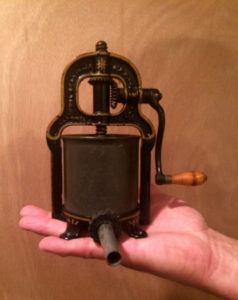 The last rare salesman sample dates to 1890, and Tressler knows of only one other, which brought $4,600 when it was sold to an auction company in Indiana. Made of cast iron and steel, the 7-inch-high sausage stuffer was made by the National Specialties Co. of Philadelphia. The full-sized product would have been manufactured for farm use only and was obsolete by the 1930s, when electric models became common. Tressler bought this treasure at an antique show in Kutztown, Pennsylvania. He said to expect this sample to fetch anywhere from $1,600 to $5,000.
The last rare salesman sample dates to 1890, and Tressler knows of only one other, which brought $4,600 when it was sold to an auction company in Indiana. Made of cast iron and steel, the 7-inch-high sausage stuffer was made by the National Specialties Co. of Philadelphia. The full-sized product would have been manufactured for farm use only and was obsolete by the 1930s, when electric models became common. Tressler bought this treasure at an antique show in Kutztown, Pennsylvania. He said to expect this sample to fetch anywhere from $1,600 to $5,000.